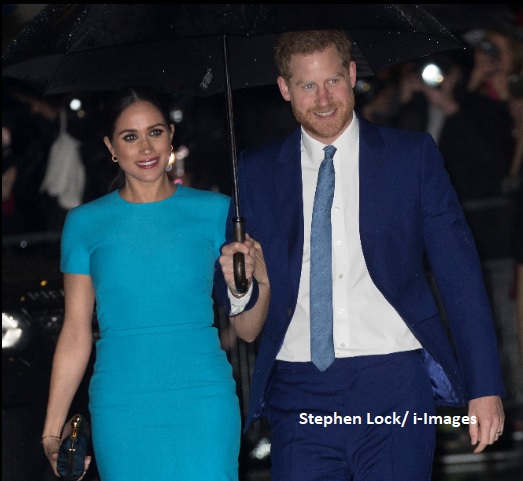
There were several surprises for those turning on the new lifestyle programme fronted by Meghan, Duchess of Sussex. One of them was the bizarre sight of The King’s daughter in law pouring pretzels from one plastic bag to another. Another came as Meghan chatted with Mindy Kaling, a friend of the duchess but not apparently so close that she didn’t know one rather basic thing about her mate. As the conversation progressed, Mindy called Meghan, well, Meghan Markle and was promptly told no. ”I’m Sussex now” said the hostess with the pretzel bag. But is she really?
Ultimately, it’s up to Meghan what she wants to call herself, just as it is for everyone else. We all know that she was born Rachel Meghan Markle. After her marriage to Prince Harry, she became the Duchess of Sussex. However, now she’s using Sussex as a surname.
Meghan follows a royal lead
It’s not without precedent. Prince William and Prince Harry both used Wales as a surname at school while Prince Edward’s wife was known as Sophie Wessex for two decades until her husband was promoted through the peerage and became Duke of Edinburgh. However, the decision to switch to Sussex has been debated, coming seven years after Meghan’s royal wedding.
Meghan told Mindy (there’s a name for a TV show all by itself) that Sussex was her family name and linked her to her children. However, both were registered with another surname and that’s where the debate starts. What is the surname of the Royal Family?
For most people, the question of what surname to put on official forms is a simple one. For the Royal Family, it’s anything but. In fact, ask the average person on the street what the surname of the Royal Family is, and you’re likely to be met with a shrug—or a hesitant guess at “Windsor.” Technically, they wouldn’t be wrong. But as with most things involving monarchy, the reality is more complicated.
The idea of the British monarch needing a surname at all is a relatively modern one. For centuries, kings and queens were simply known by their first names—Henry, Elizabeth, Victoria—often followed by a regal numeral, if required. The House to which they belonged—Plantagenet, Tudor, Stuart—functioned more like a dynastic brand than a family name in the way we understand it today.
War brings big royal change
That changed in 1917, during the reign of King George V. Amid the anti-German sentiment of the First World War, the House of Saxe-Coburg and Gotha—George’s dynastic name by virtue of his German-born grandfather Prince Albert—was quietly rebranded as the House of Windsor. It was a masterstroke of royal PR, choosing the sturdy English name of one of the monarchy’s favourite castles as a new dynastic identity. It sounded reassuringly British, even if the royal bloodline remained heavily Germanic.
So, Windsor became the name of the Royal House. But not necessarily the surname of individual royals.
The matter became even murkier in 1960, during the reign of Queen Elizabeth II. Following her marriage to Prince Philip, Duke of Edinburgh, who had taken the surname Mountbatten (an Anglicised version of Battenberg), the question arose: what surname would their children carry? In a compromise that balanced dynastic tradition and marital equality—two forces rarely in perfect harmony—Elizabeth declared that her descendants who are not styled as Prince or Princess would use the surname Mountbatten-Windsor.
This dual-barrelled name has appeared in official documents in the decades since. Prince Edward’s children, for example—Lady Louise Windsor and James, Earl of Wessex—use Mountbatten-Windsor as a surname, though it is rarely seen in public life.
Archie and Lili’s surname
Meghan and Harry’s son Archie was registered under the name Mountbatten-Windsor, a subtle signifier of his royal lineage without the styling of “Prince.” Their daughter was given the same surname on her birth in California. Since March 2023, their parents have chosen for them to be known by royal titles and they are Prince Archie of Sussex and Princess Lilibet of Sussex.
The surname Mountbatten-Windsor appears on legal documents, marriage certificates, and even court proceedings. Yet, for senior working royals, it remains largely unused in daily life. They operate more by title than by surname: The Prince of Wales, The Duke of Sussex, Princess Royal. When names are required—for example, in military records or school enrolments—some royals have used Windsor, others Mountbatten-Windsor, and occasionally just their first names and titles.
It is a naming convention that reveals much about the monarchy’s unique place in British life: both above and subject to the laws and customs of the land. While the rest of us rely on surnames to anchor us to family and history, the royals rely on an elaborate web of tradition, symbolism, and political compromise.
What next for the Mountbatten-Windsor name?
It also reflects a more modern monarchy, one negotiating its identity in an increasingly egalitarian society. The choice of Mountbatten-Windsor was, in part, a nod to Prince Philip’s desire to see his name carried forward. It’s worth noting that when his grandson Prince Harry launched his post-royal career in the US, he used the surname Wales, drawn from his former title—again demonstrating that, in this family, names are often a matter of circumstance more than birthright.
Ultimately, the Royal Family’s surname—or lack thereof—is emblematic of a broader truth. The monarchy is an institution defined less by legalities than by tradition, adaptation, and symbolism. In that light, the name they carry is both meaningful and, paradoxically, almost beside the point.
As the next generation—Prince George, Princess Charlotte, and Prince Louis—come of age, it remains to be seen what name they will carry on forms, passports, and public lives. But whether it’s Windsor, Mountbatten-Windsor, or something else entirely, the essence of monarchy remains unchanged: a name is just a name, until it isn’t.

